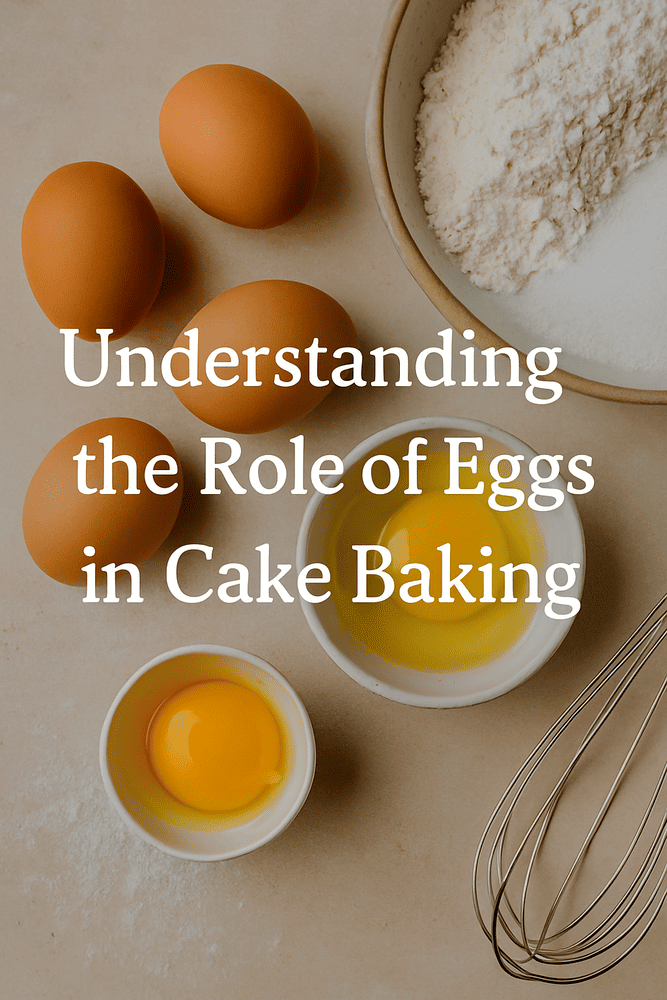Eggs are one of the most important ingredients in cake baking, but many beginners don’t realize just how vital they are. Beyond simply binding the batter, eggs play multiple roles that directly affect the texture, structure, flavor, and even the color of your cake. Understanding how eggs work will help you become a better baker and make more informed decisions when adapting recipes or troubleshooting problems.
At first glance, eggs may seem like a minor ingredient—just something you crack into the bowl along with the flour and sugar. But eggs bring both moisture and protein to the cake, and those two elements are crucial. The protein in eggs helps build structure, while the liquid content contributes to softness and moisture.
Eggs act as binders, helping hold the cake together. As the batter bakes, the proteins in the eggs set and create a network that supports the cake’s rise. Without eggs, cakes often fall apart or become crumbly. This is why many eggless cake recipes rely on alternative binders like yogurt, applesauce, or flaxseed gel—but the result is rarely identical to what eggs provide.
Another important function of eggs is leavening. When you beat eggs or egg whites, you introduce air into them. This air helps give volume to the batter and contributes to a lighter, fluffier cake. Some recipes call for eggs to be beaten separately and folded in at the end—especially in sponge cakes and chiffon cakes. The trapped air expands in the oven, lifting the cake as it bakes.
Eggs also add richness. The yolks, in particular, are full of fats that give the cake a creamy flavor and a smooth texture. They also help emulsify the batter—meaning they allow the water-based and fat-based ingredients (like milk and butter) to mix more evenly. This results in a more uniform crumb and a better mouthfeel.
The number of eggs in a recipe matters. Too few eggs can lead to a dry, crumbly cake with little structure. Too many eggs can make the cake rubbery or dense. Most standard cake recipes use about one egg per cup of flour, but some cakes—especially rich ones like pound cake—use more to achieve a denser, velvety texture.
Temperature is another key detail. Always use room temperature eggs unless the recipe states otherwise. Cold eggs can cause the batter to curdle or not mix properly with the fat, leading to an uneven texture. If you forget to take the eggs out ahead of time, just place them in warm (not hot) water for about five minutes to bring them to room temp.
Whisking eggs properly is also important. For regular cakes, you’ll typically beat the eggs with the sugar after creaming the butter and sugar together. But in foam-based cakes, like angel food or genoise, the eggs or egg whites are beaten until they form a thick, stable foam. This foam traps air and gives the cake its light texture—without using any chemical leaveners like baking powder.
Egg yolks bring color to the cake. If you’ve ever noticed a golden or yellow tone in certain cakes, it’s likely due to the number of egg yolks used. On the other hand, egg whites contribute more to volume and dryness. A white cake, for example, often uses only egg whites to maintain a pale color and a lighter crumb.
In some recipes, egg separation is essential. For instance, a sponge cake may call for yolks to be mixed with the batter and the whites to be whipped and folded in later. This technique allows you to control richness and volume separately, leading to a better-balanced cake.
Let’s look at common egg-related mistakes and how to avoid them:
- Using cold eggs → Solution: bring them to room temperature.
- Adding eggs too quickly → Solution: add one at a time, mixing well.
- Overbeating eggs → Solution: beat just until combined unless the recipe calls for foam.
- Not separating yolks and whites properly → Solution: use clean, dry tools and separate carefully.
- Substituting whole eggs with whites or vice versa → Solution: adjust recipe carefully to account for changes in fat, protein, and volume.
In vegan or allergy-friendly baking, eggs are often replaced with chia seeds, mashed banana, applesauce, or commercial egg replacers. While these can work well, they don’t always replicate the structure, flavor, and color of real eggs. If you need to substitute eggs, choose the alternative based on the specific function—binding, moisture, or leavening.
Here’s a quick summary of egg functions in cake baking:
- Structure: proteins set and support the cake
- Moisture: eggs add liquid to the batter
- Leavening: beaten eggs trap air
- Emulsifying: help blend fats and liquids
- Flavor and richness: yolks provide fat and taste
- Color: yolks add golden tones
As you experiment more with baking, you’ll begin to notice how even small changes in the number of eggs or the way they’re mixed can significantly impact your cake’s texture and appearance. Understanding the role of eggs gives you greater control over your results—and the confidence to modify recipes or create your own.
If you’ve followed our previous articles on fluffy cake techniques and essential baking tools, this piece adds valuable knowledge to help you refine your cake texture and consistency even further. And once you truly grasp the magic behind eggs, you’ll never crack one into your bowl the same way again.
